Prosthetics
Dental Prostheses are artificial teeth used to improve the oral health and aesthetics of patients with tooth loss or damage. In our dental clinic, we offer a variety of dental prostheses options in accordance with the needs and expectations of our patients. These options include fixed dentures, removable dentures and implant-supported dentures.
Dental prostheses help our patients regain their chewing, speaking and laughing functions, preserve their facial shape and increase their self-confidence. You can contact us to get more information about the dental prostheses service we offer in our dental clinic.

These are removable prostheses that can be used in jaws where there are missing teeth. In cases where fixed prostheses (such as Bridge-Covering) cannot be made, removable prostheses are used to restore the person's chewing and speech functions.
These Prostheses;
- Total Prostheses
- Partial Prostheses (popularly known as Hooked Prostheses)
- Precision Retainer Prostheses (popularly known as Snap Prostheses)
- Implant-supported Removable Prostheses (popularly known as Implant-supported Snap Prostheses)
can be classified as.
Palatal Prosthesis, as they are popularly known, are removable prostheses applied to completely edentulous jaws. It performs chewing and speaking functions with the support it receives from bone and tissue.
Are Total Dentures easy to use?
Removable (movable) prostheses are not as comfortable as fixed prostheses. However, in jaws where the amount of bone is sufficient, the support for the retention of the prostheses will increase, and the movement of the prostheses during eating, drinking and speaking will decrease. They are easy to clean because they are removable.
How long does it take to make Total Dentures?
Prostheses are prepared in an average of 5 sessions, taking approximately 1 week to 10 days.
How should Total Dentures be cleaned?
In cases where dentures are not cleaned adequately, the accumulation of food residues and bacterial plaques affects both the use of the denture and the health of the mouth and gums.
- Dentures are removed and cleaned with water and a brush. Toothpaste is not used on dentures due to its abrasive effects.
- After the prostheses is removed, gargles can be used to clean the mouth and gums.
- Special denture cleaner tablets can be used to clean dentures.
- Dentures must be removed at night, and after cleaning, they must be kept in a container filled with water overnight.
- Since they are fragile, care should be taken not to drop them during cleaning.
Can Total Dentures be repaired?
In cases such as breakage or tooth loss, it is possible to repair it quickly.
How many years can Total Prosthesis be used?
It can be used for many years if the dentures and oral care are properly maintained. The prostheses may become loose due to bone resorption that may occur over the years, or the prostheses may wear and tear due to use. In such cases, if possible, repair and nutrition; If not, the prostheses needs to be rebuilt.
Are Total Prosthesis aesthetically pleasing?
During the fitting stages, the color, structure and shape of the teeth are evaluated together by the physician and the patient in accordance with the aesthetic expectations of the patients. These are dentures that meet the aesthetic expectations of most patients because the denture is made of natural pink acrylic that mimics the color of the gums, the teeth in the denture are white acrylic teeth and they stand as a single whole.
Hooked Dentures, as they are popularly known, are removable prostheses used in cases where there are many missing teeth and these deficiencies cannot be treated with fixed prostheses. Its difference from total dentures is that it receives support from the teeth in the mouth in addition to the bones and tissues.
Is Partial Denture easy to use?
Unlike total dentures, it has better retention and is more convenient and comfortable to use, as it receives support from the teeth with metal hooks on it. They are easy to clean because they are removable. However, it is still not as comfortable as fixed dentures. Since metal hooks are located on the teeth, they limit the movement of the prostheses and prevent it from coming out. However, when these hooks extend over the front teeth, they cause aesthetic problems.
How long does it take to make a Partial Denture?
Prostheses are prepared in an average of 5 sessions, taking approximately 1 week to 10 days.
How should partial dentures be cleaned?
Cleaning of dentures is important. In cases where it is not cleaned adequately, the accumulation of food residues and bacterial plaques affects both the use of the prostheses and the health of the teeth and gums.
- Dentures are removed and cleaned with water and a brush. Toothpaste is not used on dentures due to its abrasive effects.
- After the prostheses are removed, the teeth are brushed, mouthwash and dental floss are recommended.
- Special denture cleaner tablets can be used to clean dentures.
- Dentures must be removed at night, and after cleaning, they must be kept in a container filled with water overnight.
- Since they are fragile, care should be taken not to drop them during cleaning.
Can Partial Dentures be repaired?
It is possible to repair situations such as fractures in the prostheses or tooth loss. However, repairing breaks in metal hooks is more difficult. In case of loss (extraction) of one of the teeth in the mouth, the prostheses can be made usable again by adding teeth to the existing prostheses.
How long are Partial Dentures used?
If the prostheses is maintained and cleaned, and oral and dental health is taken care of, the prostheses can be used for many years.
- Loosening of the prostheses due to bone loss over time,
- Breakage of metal hooks due to wear and tear,
- Loss of teeth supported in the mouth
Reasons such as these require the prostheses to be repaired if possible, or to be rebuilt if not.
Are partial dentures aesthetically pleasing?
During the fitting stages, the color, structure and shape of the teeth are evaluated together by the physician and the patient in accordance with the aesthetic expectations of the patients. In partial dentures, the position of the supported teeth in the mouth affects the aesthetics. In dentures supported by the front teeth, the hook will remain in the visible area, negatively affecting the aesthetic appearance. In dentures supported by the back teeth, more aesthetic results are obtained because the smile area will be a single whole.
Deflex Prostheses, also known as Unbreakable Prostheses, is made of semi-elastic material;
- In patients with low tolerance to prostheses use,
- In patients who have frequently experienced dents during prostheses use,
- In patients who do not want a surgical procedure in cases where the bone structure is irregularly protruding,
- It is used as a transitional prostheses before switching to permanent prostheses, to help patients get used to the use and gain their functions.
It also meets the aesthetic expectations of patients with its elastic structure, transparent appearance and the fact that it can be prepared without the use of metal hooks in cases where support will be taken from the teeth.
Snap Dentures, as they are popularly known, are preferred in cases where there are many missing teeth, such as partial dentures, but these deficiencies cannot be rehabilitated with fixed dentures. Unlike partial dentures, there are no metal hooks; instead, the retaining parts are hidden inside the denture on the teeth. These parts fit together like a key and lock, preventing the movement of the prostheses.
Another difference between these dentures is that Partial Dentures can be made without any operation on existing teeth. In Precision Retained Dentures, the teeth in the mouth must be covered to place the retaining parts.
Is the Precision Retained Prostheses easy to use?
Since retention is provided by retaining parts placed on the teeth and hidden inside the prostheses, it is both more comfortable to use and more aesthetic than hooked dentures. Cleaning the denture is easier than fixed dentures because it is removed and done by hand.
How long does it take to make a Precision Retained Denture?
The construction process, which starts with the coating of some existing teeth in the mouth, takes an average of 2 weeks.
Can Precision Retained Dentures be repaired?
If the tires, which are one of the holding parts, become loose or come off, it is possible to replace the tire, but it is not possible to repair the fractures that occur in these parts. Situations such as fractures in other parts of the prostheses or tooth loss can be repaired. If the prostheses is thought to be compatible with veneers, prosthetic planning must be re-planned in case of tooth loss (extraction).
How to clean Precision Retainer Denture?
In cases where the prostheses and teeth cannot be cleaned adequately, the accumulation of food residues and bacterial plaques affects both the use of the prostheses and the health of teeth and gums. Therefore, in addition to cleaning the teeth, the cleaning of the denture is also very important.
- Dentures are removed and cleaned with water and a brush. Toothpaste is not used on dentures due to its abrasive effects.
- After the prostheses is removed, the teeth are brushed, and specially produced brushes and oral irrigators can be used to easily clean the bridges and crowns in the mouth.
- Special denture cleaner tablets can be used to clean dentures.
- Dentures must be removed at night, and after cleaning, they must be kept in a container filled with water overnight.
- Since they are fragile, care should be taken not to drop them during cleaning.
How long are Precision Retained Dentures used?
If the prostheses is maintained and cleaned, and oral and dental health is taken care of, the prostheses can be used for many years.
- Over time, the retaining tires loosen and in these cases, the tires are replaced and use continues.
- Over time, the prostheses becomes looser due to bone loss, and in such cases, it is repaired if possible.
- In case of loss of support teeth, the prostheses must be remade.
Are Precision Retained Dentures aesthetically pleasing?
During the fitting stages, the color, structure and shape of both the veneered teeth and the teeth to be included in the prostheses are evaluated together by the physician and the patient in accordance with the aesthetic expectations of the patients.
In precision retainer dentures, unlike hooked dentures, the retainer parts remain inside the prostheses and are not visible. For this reason, it is not possible for the holder part to spoil the aesthetics. Other teeth in the mouth are covered in prostheses construction. For this reason, both the crowned teeth and the teeth on the prostheses are seen as a whole, and an aesthetic smile with the desired color and structure is presented to the patients.
Fixed prostheses; These are treatments in which single or multiple tooth deficiencies are eliminated (bridge) or a single tooth (crown) is restored. The teeth to be used in crown or bridge construction are reduced and prepared for treatment. The treatment is completed by gluing the teeth specially made for the patient in the laboratory onto the reduced teeth.
- These are prostheses made on implants applied to completely edentulous jaws, with support from these implants, and where all missing teeth are replaced.
- It is used in cases where missing teeth need to be treated with removable dentures.
- Using clinical examination and radiological imaging techniques, bone structure and intraoral tissues are examined and the most appropriate treatment method for the patients is determined.
- Implants, which are generally titanium-based, bond with the bone after placement and mimic tooth roots. These implants not only support the teeth that will be placed on them, allowing them to perform their functions, but also prevent bone loss and resorption by supporting the surrounding bone tissues.
If the missing tooth is not treated with a bridge or implant after tooth extraction, the adjacent teeth and the tooth in the opposite jaw will move towards the extracted tooth gap. This causes gum disease, cavities, and shifting teeth in the future. In long-term missing teeth, the amount of bone in the toothless area decreases.
Fixed dentures cannot be removed by the patient and they do not move during chewing and speaking. Additionally, since it mimics the patient's pre-existing teeth, it is easy for the patient to get used to and use.
No! It can be treated by placing implants that mimic tooth roots in the extracted tooth cavity.
Fixed Prosthetics on Implants
These are treatments for single, multiple, or total toothless patients where the missing teeth are replaced. Treatment is planned according to the number of missing teeth, bone quantity, and quality in the area. Single tooth loss is treated with crown-supported implants, while a few missing teeth are treated with bridge-supported implants. For totally toothless patients, fixed prosthetics can be made over 4 or 6 implants depending on bone quantity and other conditions. In cases where fixed prosthetics cannot be applied, movable prosthetics on implants can be made by placing 2 or 3 implants in the anterior region.
Implant-Supported Movable Prosthetics
It involves treating fully toothless mouths with two or three implants placed in the anterior region. They rely on attachments on implants, hence commonly known as snap-on prosthetics. These are applied when fixed prosthetics on implants are not feasible due to severe bone loss. It consists of implants placed in the anterior region and the snap-on removable prosthesis attached to the implants.
Are Fixed Prosthetics on Implants easy to use?
Fixed prosthetics offer a more comfortable usage compared to removable prosthetics that are taken in and out. They feel closest to your natural teeth. There is no movement in the prosthesis during functions such as eating, drinking, or speaking. Since there is no need for support from tissues like in removable prosthetics, they take up much less space in the mouth, which particularly facilitates the comfortable use of the prosthesis in patients prone to nausea reflex.
Do Fixed Prosthetics on Implants meet my aesthetic expectations?
The teeth placed on implants are made of materials like porcelain or zirconium, resembling the natural tooth color. During the fabrication of the prosthesis, the structure, color, and shape of the teeth can be determined by the patients during trials. Since there is no metal visibility and no metal reflection affecting the naturalness of the teeth, fixed prosthetics supported by implants meet patients' aesthetic expectations.
How is the cleaning of Fixed Prosthetics on Implants done?
- We should brush with soft toothbrushes for at least 2 minutes just like we normally brush our teeth.
- After brushing with mouth rinses, we should support our oral hygiene.
- In addition to daily dental care routine, the accumulation of plaque under the prosthetics affects gum and implant health negatively. Since it is difficult to reach these areas, cleaning is also challenging. The use of oral showers can easily clean these areas that cannot be reached by brushing. Implant surroundings must be cleaned with the help of oral showers and dental flosses with every cleaning.
How long does it take to make Fixed Prosthetics on Implants?
- Implant applications are done in a single day, and implants provide fusion with jawbones in an average of 2 to 3 months. Preparation of permanent prosthetics starts after this fusion is achieved, and the prosthetics are completed in approximately 2 weeks.
- Temporary prosthetics are made for patients not to be toothless until the time permanent prosthetics are made. Until the day the permanent prosthesis is placed, these temporary teeth allow functions such as chewing-speaking to continue and enable patients to have a trial before their permanent prosthetics.
These are prosthetics used by relying on implants applied to fully toothless jaws, which can be attached and removed for use. They are formed by the interlocking of the key-lock system of the retaining parts inside the prosthesis with the connectors placed on the implants. Therefore, they are also known as Snap-On Prosthetics in the community.
For implant-supported removable prosthetics, a minimum of 2 implants in the lower jaw and at least 3 implants in the upper jaw are required. They are preferred when bone support does not allow for a higher number of implants instead of fixed prosthetics.
Implants provide stabilization and support for the upcoming prosthetics while meeting the functions of the prosthesis. They also prevent bone loss and resorption in the implanted area.
What are the types of Implant-Supported Removable Prosthetics?
The number of implants that can be made depends on the suitability of the bone. An increase in the number of implants will also increase retention.
- + Prosthesis with Ball Attachment on Implants;
The button-shaped pieces placed on implants stabilize by fitting into prepared sockets inside the prosthesis. These pieces interlock with each other, limiting the movement of the prosthesis during eating, drinking, or speaking. - + Prosthesis with Locater Attachment on Implants;
In the Locater attachment prosthesis, which can also be made with 2 implants in the lower jaw, pieces called locators are placed on the implants inserted into the jawbone. There are sockets and rubbers inside the prosthesis for these locators to fit into. These two parts unite in a key-lock fit, preventing the movement of the prosthesis. Retention increases with an increase in the number of implants. - + Prosthesis with Bar Attachment on Implants;
A bar system can be used on 3 or more implants made. In this system, there is a socket and rubber system inside the prosthesis where the bar will be placed. With this union, the movement of the prosthesis is prevented. Retention is better than the Locater system made with 2 implants.
What is the Difference and Advantage of Implant-Supported Removable Prosthetics from Total Denture Prosthetics?
Total denture prosthetics rely on support from bone and surrounding tissues, and in cases where bone support is inadequate, the prosthesis moves due to the effect of muscles and the tongue during eating and speaking. This movement prevents the comfortable use of the prosthesis by the patient.
Implant-supported removable prosthetics receive support from implants placed within the jawbones. Thanks to this support, the movement and displacement of the prosthesis during activities such as speaking and chewing are prevented. Since support is obtained from implants instead of tissues, the area covered by implant-supported prosthetics is smaller than that of total denture prosthetics. This increases comfort during use, especially for patients with a high nausea reflex and complaints about the size of their prosthetics.
Is the Use of Implant-Supported Removable Prosthetics Easy?
Since retention occurs on the implants and by the retaining parts inside the prosthesis, the movement during prosthesis usage is minimal. Since support is obtained from implants instead of tissues for retention, the area covered by implant-supported prosthetics is smaller than that of total denture prosthetics. Thus, patients are both comfortable during use and have a shorter adaptation period.
How Long Does it Take to Make Implant-Supported Removable Prosthetics?
These prosthetics should be evaluated in two stages.
-
Implant Application;
Implants are applied under local anesthesia in a clinical setting or under general anesthesia in an operating room in a single day.The fusion of implants with bone and the healing process takes approximately 2-3 months.
-
Prosthesis Making;
After the healing is completed, the production of the prosthesis begins, and the prosthesis is completed within approximately 1-2 weeks.Temporary prosthetics are prepared for patients not to be toothless during the waiting period until the permanent prosthetics are made after implantation. Thus, patients both go through the adaptation process by performing a trial of their permanent prosthetics and regain functions such as chewing and speaking.
Are Implant-Supported Removable Prosthetics Aesthetic?
During trial stages, the color, structure, and shape of the teeth are determined according to the aesthetic expectations of the patients. Being made of natural pink acrylic imitating gum color, having white acrylic teeth in the prosthesis, standing as a single whole, and not showing retaining parts, any metal appearance, or reflection make them quite aesthetic. They satisfy the aesthetic expectations of most patients.
How to Clean Implant-Supported Removable Prosthetics?
If prosthetics are not cleaned adequately, the accumulation of food residues and bacterial plaques affects both the use of the prosthesis and the health of the implants. Therefore, prosthesis cleaning is very important.
- Prosthetics are removed and cleaned with water and a brush. Toothpaste is not used on the prosthesis due to its abrasive effects.
- After removing the prosthesis, gargles can be done for cleaning the oral cavity and gums, and cleaning around the implants.
- Special prosthesis cleaning tablets can be used for cleaning the prosthetics.
- Prosthetics must be removed at night and kept in a container filled with water after cleaning.
- Since they are fragile, care should be taken not to drop them during cleaning.
Is Repairing Implant-Supported Prosthetics Possible?
Repair of fractures in the prosthetic part or situations such as tooth loss is possible. However, in cases affecting the connection points of the implant or fractures occurring in these connections, it may be necessary to renew the prosthesis.
How Long Can Implant-Supported Prosthetics Be Used?
Prosthetics can be used for many years if their maintenance and cleaning are regularly performed, and attention is paid to the cleanliness of the implants and surrounding tissues in the mouth.
In case of looseness in the prosthetics due to bone loss over time, repairs are made if possible, and if not possible, they are renewed. As long as implants do not lose bone support, renewal of prosthetics is possible.
How Long After Implantation is the Prosthesis Attached?
Approximately 2-3 months are required for the fusion of bone-tissue-implant and for the implant to fully settle within the bone after implantation. Production of the prosthesis begins after this period, and the prosthesis is completed within approximately 2 weeks. Your dentist will provide you with specific information on this matter.
Immediately after implantation, temporary prosthetics are prepared based on the measurements taken with the placement of the implants so that our patients do not remain toothless during the waiting period of 2-3 months. With these prosthetics, patients are neither toothless during the healing period nor have a trial of their permanent prosthetics to be made in the future.
Types of Veneers Used in Dentistry
(Which material and which type of prostheses do we prefer for patients? Laminated? Veneer (crown)?)
What are laminate veneers and crowns?
First of all, in order to eliminate the confusion in patients, it is necessary to explain the difference between laminate veneer and crown. Both are treatments performed on a single tooth. While laminate is applied only to the front part of the tooth, the crown (veneer) surrounds the tooth all around.
-
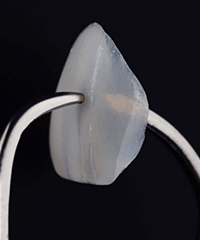
Lamine -
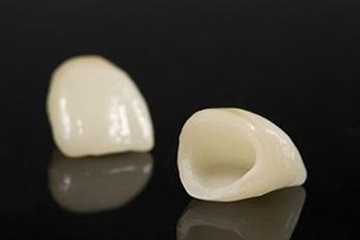
Crown
When should laminate and when crown be applied?
If there are old fillings in the teeth and the structural integrity of the tooth is seriously damaged, we prefer to make a "crown" to structurally strengthen the tooth. However, if your teeth have not undergone any structural repairs and are sound, it would be a better choice to apply laminate only to the front surface of the teeth for aesthetic purposes.
What materials do we use when making crowns and laminates?
The types of materials we use in "laminate veneer", commonly known as leaf porcelain, are as follows;
-
Lithium Disilicate material is a type of ceramic with high glass content. It is the material we prefer most when making laminate. Many world-famous brands produce lithium disilicate ceramics. The most well-known of these is the e.max® model from the “Ivoclar vivodent” brand. That's why leaf porcelains, or laminates, are sometimes called e.max®. Apart from this, lithium disilicate materials of many brands are available. For example: GC-Initial LiSi, Densply-Tessera
-
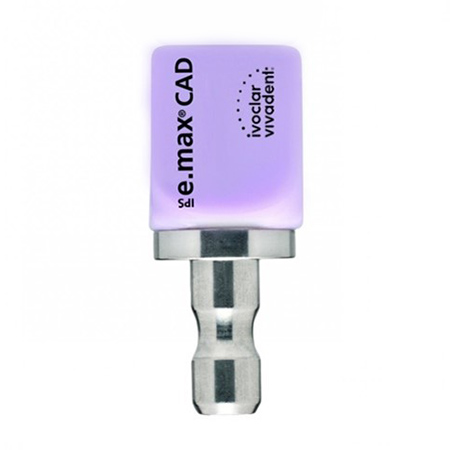
Ivoclar vivodent -

GC- Initial LiSi -
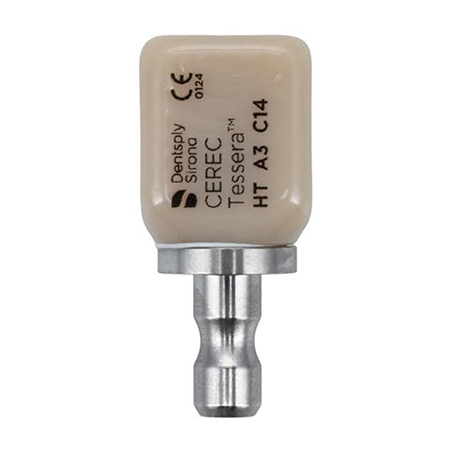
Densply-Tessera
-
-
Laminate production is also available with many types of materials such as feldspathic porcelains, leucite-reinforced porcelains and alumina.
However, today, lithium disilicates are preferred for many reasons such as diversity, ease of production and supply, variety of color makeup, and compressive strength. (e.max®, Tessera, Initial LiSi)
-
What is zirconium and where is it used?
Zirconium oxide material is produced by passing the zirconium mineral found in nature through various stages. This material, which is used in many areas, has become very popular in dentistry in recent years. Especially its white color plays an important role in its preference over metal alloys in dentistry. Manufacturers produce zirconium oxide material in many shades of white through various processes and have even been able to add slight transparency to the completely opaque white zirconium oxide by combining it with some materials in recent years. However, we do not prefer zirconium oxides in the production of "lamina" (leaf porcelain). The more transparent and more glass-like structure of the materials mentioned above can better imitate natural teeth. However, zirconiums still have many advantages and offer better aesthetics than metal-supported porcelains.
-
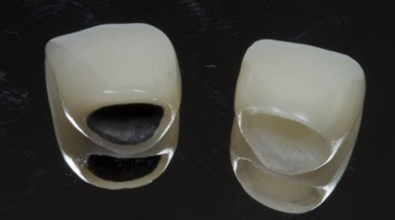
Crown Veneers -
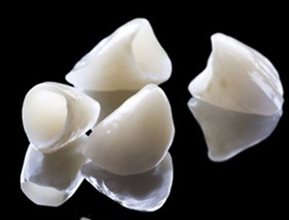
Crown Veneers
What materials do we prefer when making crowns?
A crown is a type of prostheses that surrounds the tooth all around. In this way, we structurally strengthen excessively damaged teeth or teeth with many fillings. There are many options for materials. These are glass ceramics (lithium disilicates), metal-based porcelains, and zirconium-based porcelains. We evaluate these materials in terms of aesthetics and durability and recommend the most appropriate material selection to the patient and perform their treatments.
What is the difference between a crown and a bridge? What materials can it be made with?
Crowns are prostheses made for a single tooth. A bridge is a type of prostheses made by combining the missing teeth with the adjacent teeth in case of missing teeth. We try to choose high-strength materials when building the bridge. These materials are metal-based porcelains, zirconium-based porcelains, and bridges made entirely of zirconium (monolithic zirconiums).
-
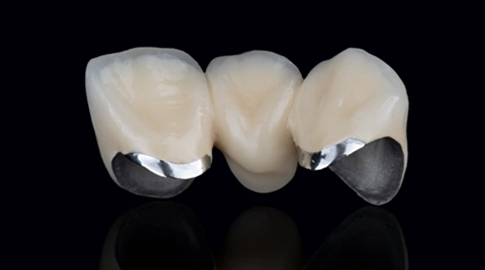
Bridge -
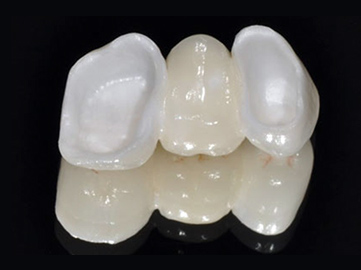
Bridge
What are the types of zirconium? What is monolithic zirconium?
We mentioned many different materials above, it is also possible to classify zirconium, which is widely used today. We prefer zirconium when making bridges or crowns. We decide which type of zirconium material we will use according to the aesthetic or durability needs of the teeth. It is possible to classify these simply as zirconium-based prostheses and monolithic zirconium. In zirconium-based prostheses, a substructure is produced for the bridge or crown, then porcelain powder is added to the upper part by hand workmanship, thus aiming to make a more aesthetic prostheses. Monolithic zirconiums, on the other hand, are produced directly in the form of teeth, and a monolithic tooth structure is obtained completely by computer design, without any manual labor. This monolithic structure brings greater strength.
With today's developing technology, it is possible to produce all of these materials using computers, three-dimensional printers and three-dimensional scraper (cad-cam) technologies. As Private Jimer Dental Clinics, we take dental measurements with special three-dimensional intraoral scanners in our clinic and also use completely digital technologies in the production of your teeth. In this way, we obtain your teeth with higher technology, higher quality materials and more precise production.
We use many materials in dentistry. It is possible to apply the most suitable material for you in our clinics by evaluating it with your dentist in terms of aesthetics, durability and cost.
Take advantage of our Prosthetics service now!
Complete the form to receive complimentary 5 star hotel, spa services, breakfast, and vip transfer.
 TR
TR DE
DE


